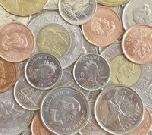
 |
|
| Financial Terms | |
| Scale in |
|
Information about financial, finance, business, accounting, payroll, inventory, investment, money, inventory control, stock trading, financial advisor, tax advisor, credit.
Main Page: financial advisor, accounting, inventory control, investment, business, credit, payroll, finance, Also see related: financing, homebuying, home, property, real estate, condo, first time homebuyer, homebuyer, home buyer, |
Definition of Scale in
Scale inWhen a trader or investor gradually takes a position in a security or market over time.
Related Terms:Logarithmic ScaleA scale in which equal proportions are shown as equal distances so that, for example, a doubling from 2 to 4 is represented by one inch, as is a doubling from 4 to 8. Ratio ScaleSee logarithmic scale. DLOM (discount for lack of marketability)an amount or percentage deducted from an equity interest to reflect lack of marketability. economic components modelAbrams’ model for calculating DLOM based on the interaction of discounts from four economic components. QMDM (quantitative marketability discount model)model for calculating DLOM for minority interests r the discount rate Absolute priorityRule in bankruptcy proceedings whereby senior creditors are required to be paid in full Accelerated cost recovery system (ACRS)Schedule of depreciation rates allowed for tax purposes.  Accounting insolvencyTotal liabilities exceed total assets. A firm with a negative net worth is insolvent on Accounts receivable turnoverThe ratio of net credit sales to average accounts receivable, a measure of how All or noneRequirement that none of an order be executed unless all of it can be executed at the specified price. All-or-none underwritingAn arrangement whereby a security issue is canceled if the underwriter is unable Asset-backed securityA security that is collateralized by loans, leases, receivables, or installment contracts Asset-coverage testA bond indenture restriction that permits additional borrowing on if the ratio of assets to Asset turnoverThe ratio of net sales to total assets. At-the-moneyAn option is at-the-money if the strike price of the option is equal to the market price of the Auction marketsmarkets in which the prevailing price is determined through the free interaction of  Bear marketAny market in which prices are in a declining trend. Black marketAn illegal market. Break-even timeRelated: Premium payback period. Brokered marketA market where an intermediary offers search services to buyers and sellers. Bull marketAny market in which prices are in an upward trend. Bulldog marketThe foreign market in the United Kingdom. Call money rateAlso called the broker loan rate , the interest rate that banks charge brokers to finance Capital marketThe market for trading long-term debt instruments (those that mature in more than one year). Capital market efficiencyReflects the relative amount of wealth wasted in making transactions. An efficient Capital market imperfections viewThe view that issuing debt is generally valuable but that the firm's Capital market line (CML)The line defined by every combination of the risk-free asset and the market portfolio.  Cash flow coverage ratioThe number of times that financial obligations (for interest, principal payments, Cash flow time-lineLine depicting the operating activities and cash flows for a firm over a particular period. Cash marketsAlso called spot markets, these are markets that involve the immediate delivery of a security Changes in Financial Positionsources of funds internally provided from operations that alter a company's Clear a positionTo eliminate a long or short position, leaving no ownership or obligation. Common marketAn agreement between two or more countries that permits the free movement of capital Common stock marketThe market for trading equities, not including preferred stock. Comparison universeThe collection of money managers of similar investment style used for assessing Complete capital marketA market in which there is a distinct marketable security for each and every CompositionVoluntary arrangement to restructure a firm's debt, under which payment is reduced. ConsolA type of bond that has an infinite life but is not issued in the U.S. capital markets. ConsolidationThe combining of two or more firms to form an entirely new entity. Consortium banksA merchant banking subsidiary set up by several banks that may or may not be of the Convertible securityA security that can be converted into common stock at the option of the security holder, Corner A MarketTo purchase enough of the available supply of a commodity or stock in order to CoverThe purchase of a contract to offset a previously established short position. Coverage ratiosRatios used to test the adequacy of cash flows generated through earnings for purposes of Covered callA short call option position in which the writer owns the number of shares of the underlying Covered call writing strategyA strategy that involves writing a call option on securities that the investor Covered interest arbitrageA portfolio manager invests dollars in an instrument denominated in a foreign Covered or hedge option strategiesStrategies that involve a position in an option as well as a position in the Covered PutA put option position in which the option writer also is short the corresponding stock or has Crossover rateThe return at which two alternative projects have the same net present value. Dealer marketA market where traders specializing in particular commodities buy and sell assets for their Debt marketThe market for trading debt instruments. Debt-service coverage ratioEarnings before interest and income taxes plus one-third rental charges, divided Deductive reasoningThe use of general fact to provide accurate information about a specific situation. Derivative marketsmarkets for derivative instruments. Derivative securityA financial security, such as an option, or future, whose value is derived in part from the Direct search marketBuyers and sellers seek each other directly and transact directly. Doctrine of sovereign immunityDoctrine that says a nation may not be tried in the courts of another country Domestic marketPart of a nation's internal market representing the mechanisms for issuing and trading Doubling optionA sinking fund provision that may allow repurchase of twice the required number of bonds Dow Jones industrial averageThis is the best known U.S.index of stocks. It contains 30 stocks that trade on Economies of scaleThe decrease in the marginal cost of production as a plant's scale of operations increases. Efficient capital marketA market in which new information is very quickly reflected accurately in share Efficient Market HypothesisIn general the hypothesis states that all relevant information is fully and Either-way marketIn the interbank Eurodollar deposit market, an either-way market is one in which the bid Emerging marketsThe financial markets of developing economies. Employee stock ownership plan (ESOP)A company contributes to a trust fund that buys stock on behalf of Equilibrium market price of riskThe slope of the capital market line (CML). Since the CML represents the Equity marketRelated:Stock market Eurocurrency marketThe money market for borrowing and lending currencies that are held in the form of European Monetary System (EMS)An exchange arrangement formed in 1979 that involves the currencies Excess return on the market portfolioThe difference between the return on the market portfolio and the Exchangeable Securitysecurity that grants the security holder the right to exchange the security for the External marketAlso referred to as the international market, the offshore market, or, more popularly, the Fair market priceAmount at which an asset would change hands between two parties, both having Federal funds marketThe market where banks can borrow or lend reserves, allowing banks temporarily Financial marketAn organized institutional structure or mechanism for creating and exchanging financial assets. Fixed asset turnover ratioThe ratio of sales to fixed assets. Fixed-charge coverage ratioA measure of a firm's ability to meet its fixed-charge obligations: the ratio of Fixed-dollar securityA nonnegotiable debt security that can be redeemed at some fixed price or according to Fixed-income marketThe market for trading bonds and preferred stock. Flat price (also clean price)The quoted newspaper price of a bond that does not include accrued interest. Floor traderA member who generally trades only for his own account, for an account controlled by him or Foreign banking marketThat portion of domestic bank loans supplied to foreigners for use abroad. Foreign bond marketThat portion of the domestic bond market that represents issues floated by foreign Foreign equity marketThat portion of the domestic equity market that represents issues floated by foreign companies. Foreign marketPart of a nation's internal market, representing the mechanisms for issuing and trading Foreign market betaA measure of foreign market risk that is derived from the capital asset pricing model. Forward coverPurchase or sale of forward foreign currency in order to offset a known future cash flow. Forward marketA market in which participants agree to trade some commodity, security, or foreign Fourth marketDirect trading in exchange-listed securities between investors without the use of a broker. Futures marketA market in which contracts for future delivery of a commodity or a security are bought or sold. Government bondSee: Government securities. Government National Mortgage Association (Ginnie Mae)A wholly owned U.S. government corporation Government sponsored enterprisesPrivately owned, publicly chartered entities, such as the Student Loan Government securitiesNegotiable U.S. Treasury securities. Gray marketPurchases and sales of eurobonds that occur before the issue price is finally set. Host securityThe security to which a warrant is attached. Hot moneyMoney that moves across country borders in response to interest rate differences and that moves Hybrid securityA convertible security whose optioned common stock is trading in a middle range, causing Index and Option Market (IOM)A division of the CME established in 1982 for trading stock index Inductive reasoningThe attempt to use information about a specific situation to draw a conclusion. Related to : financial, finance, business, accounting, payroll, inventory, investment, money, inventory control, stock trading, financial advisor, tax advisor, credit. |